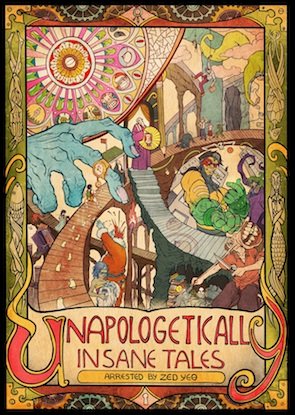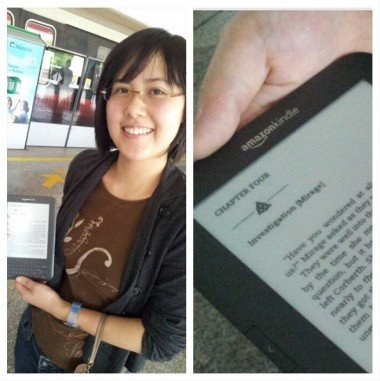Interview with Zed Yeo, author of Unapologetically Insane Tales
23 Dec 2013 [Interviews]
Not long after the launch of Unapologetically Insane Tales, Zed Yeo agreed to be interviewed for this blog.
1. Tell us about your journey (and struggle, if any) to becoming a published author.
Becoming a published author is the same as growing up. You pick up age as you come along, gather calcium, bones grow, muscles stretch, features alter and suddenly you're an adult. It takes a few years. It’s not necessarily easy.
I had some ideas, added words, altered them (numerous times), shapeshifted the plots, got them organised and I printed them and I'm published. I took a few years. I did not still do not think it was easy. He laughs.
Struggles? They come in voices. Get a real job. Don’t la. You cannot write in Singapore. Don’t be selfish. You can write as a hobby. I’ve heard those words from people who matter, including myself. Because these people are close to you, these words echo and linger. Real job? For me it’s the penultimate job. (haha, pen-ultimate. Get it?)
On publishing:
For me, publishing is not just about writing. Writing needs to be complemented with a suitable cover, keen editing, and good layout plus typesetting. So I need a sincere team, and that’s not always readily available. Then after that, it’s to get the stories out there, and make sure that the book – a work born of several persons’ efforts – reaches its desired audience. There’s a reader for every book. I do not stop at publishing. That alone has never been the goal. The goal is to put the book, the stories, in front of appreciative audience. Otherwise, being published is the same as staying unpublished. I can get quite serious about this book thing, but that’s the only way I know how to do this.
2. Do you have a writing routine?
I write something every day, even if it's just a sentence. I think the skill of writing is a like a muscle that needs to be used and conditioned. It atrophies if I don't exercise it. My ideal routine is to add 400 words to my novel every day. I can’t say I’ve been managing. But more or less, I manage to write at least one sentence every day. It’s great practice.
With a day job (librarian), it’s challenging. It’s not the same in Singapore as in some other countries. We work really hard at work, and sometimes, after work we work some more. Add that to the fact that I’m an independent writer, which means I have to look after the entire production of the book – illustration, editing, layout, marketing, distribution, sales – I wind up with very little time to write. When I do write, I have to work deep into the night.
Incidentally, writing is not the only thing a writer needs to do. He needs to read voraciously to improve. If you’re a sportsman, you need a coach right? Guess who could coach a writer? Other writers, of course. Read a lot, learn a lot. I do that consciously. When I read, I analyse. What are the literary devices employed, how are they employed, how does this writer do humour, how does that writer do imageries, here’s a good bit of dramatic irony, that’s a very clever way to create tension, and it goes on… and on… and on… I read in an article that a devoted practitioner of any field or arts, when he examines a work from his field (eg. a playwright watching a play), his brain actually is engaged at a somewhat creative level, consuming more energy compared to a non-practitioner, because he would be interacting with that piece of work in his head – how to make it better, why is it good and such questions and answers chase each other in his head. I suppose it’s not dissimilar to when I read books.
3. How long did you take to write your book Unapologetically Insane Tales?
I took about 6 years to produce this book. Most of the stories have been heavily edited more than ten times. The writing process, took about 3 years? I can’t actually remember anymore. But an estimate would be three years. I worked on the editing, layout, printing, marketing after that for another three years, in between work. Of course, I continued making small changes here and there during the final 3 years, but I would say the bulk of the writing had been done in the first three years.
I think the book could still be better. I’m almost certain that there would still be grammatical errors that persist despite multiple pairs of editorial eyes, trying to laser vision all those pesky grammar bugs to death, but they have a cockroachian toughness, these damned bugs. But one has to move on. I have so many more stories to write. I just need to move on.
4. The cover illustration has an art-deco feel, was this something that you discussed with the illustrator? Did the illustrator read the book before creating the cover, or was it based on conversations with you?
The artist is Sara Chong. She’s now very accomplished. Back then, she was a relatively new freelancer. I let her read it and said that she should only illustrate for the book if she likes the stories. Affinity is important when you look for an artist. You need to feel for a subject before you could really put our heart to it, so that's what I sought in my artist. Whether she liked it enough, you know the answer ☺
She asked if I had anything in mind, and I told her to have a free hand at it. She couldn't decide which story to feature at for the cover because she thought every one ought to be featured. So she threw everything into a cauldron and from the bubbles arose the cover art.
Following from this, she’d like to do more book illustrations and it’s one of the things she enjoys most about working as an illustrator. I think we can look forward to more good stuff from her.
5. How did you decide to use crowd funding to get your book published? Would you do it again?
Mine was a book that was so avant garde, in its manuscript form, publishers just did not give it a second glance. So I took things into my own hands and went ahead to source for illustrators, layout artists and editors. Suddenly I had a book, that nobody knew about.
Crowdfunding is perfect for this book, because it is targeted at adults, who happen to have the means to do internet purchases. It’s an especially good platform for anything quirky and unconventional. You need to be outstandingly refreshing to stand a chance of success. I saw a good fit for my book, which was anything but the norm. It’s a matter of placing the product at the right place. You put a porpoise in the ocean it’ll do well. But if you put it in the Bukit Timah hill, it’s dead.
Will I do it again? Who knows? ☺ My focus now is entirely on writing new stories. Deciding the means to market and distribute the book is sort of jumping the gun. Step by step. After I’ve got the goods, if it’s suitable, then I’ll decide.
6. What’s next in the pipeline for you, writing-wise?
I’ve got two young adult fiction series. I’ve begun on both of them, but will eventually have to pick one to focus on. This is very difficult because I like both of them. One is about an orphan girl who gets thrown into dreams and learns that she’s a fade (someone who lives in dreams). Her mentor is a handsome young man with a penchant for appearing out of the blue – he can teleport. She will learn that she has interesting talents of her own, and she’ll need them. Because her homeworld, can be quite the nightmare.
The other is about a young man who gets conscripted into a dubious unit for his National Service. There are unmentionable things, and the country has a unit who deals with them.
I’m also looking at a children’s urban fantasy series. Too many ideas, just need the time to work on them. I’m thinking through my life and might be making time for these books.
I need to work very hard, because I’m not too young anymore, writing-wise. Haha!
--
Unapologetically Insane Tales is available in bookstores now, including Kinokuniya, Times, MPH, Select Books, and BooksActually.

